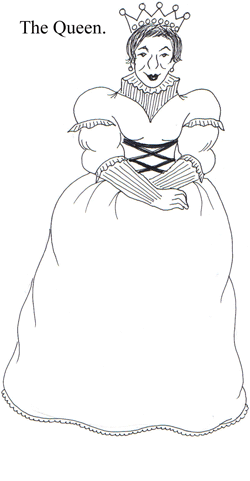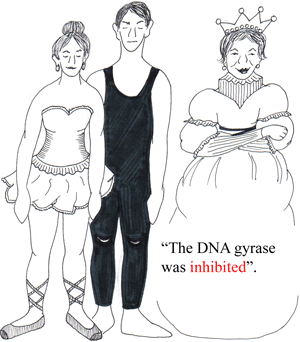September 17, 2006
Quinolones
MECHANISM OF ACTION
• Bactericidal
• Inhibit bacterial DNA gyrase, topoisomerase IV, and two type II DNA topoisomerase enzymes
• For many gram-positive bacteria (such as S. aureus), topoisomerase IV is the primary activity inhibited by the quinolone (see gyrating dancers below)
• For many gram-negative bacteria (such as E. coli), DNA gyrase is the primary activity inhibited by the quinolone (see "queen" below stopping the gyrating dancers)
ABSORPTION/EXCRETION
• Quinolones are well absorbed after oral administration and are distributed widely in body tissues
• Bioavailability: for the fluoroquinolones it is greater than 50% for all agents and greater than 95% for several
• Volume of distribution: (high) The concentrations of quinolones in urine, kidney, lung and prostate tissue, stool, bile, and macrophages and neutrophils are higher than serum levels. Quinolone concentrations in cerebrospinal fluid, bone, and prostatic fluid are lower than in serum.
• Excretion: Most quinolones are cleared predominantly by the kidney, and dosages must be adjusted for renal failure. However, pefloxacin and moxifloxacin are metabolized predominantly by the liver and should not be used in patients with hepatic failure.

ANTIMICROBIAL SPECTRUM
• bactericidal against: E. coli and various species of Salmonella, Shigella, Enterobacter, Campylobacter, and Neisseria
• Third generation fluoroquinolones : levofloxacin, moxifloxacin, and gatifloxacin. They possess antibacterial activity against Chlamydia, Legionella, and Mycoplasma species, streptococcal, staphylococcal pathogens, and variable activity against E. faecalis
THERAPEUTIC USES
• Prostatitis: Norfloxacin, ciprofloxacin, and ofloxacin
• Sexually Transmitted Diseases: activity in vitro against N. gonorrhoeae, C. trachomatis, and H. ducreyi
• Gastrointestinal infections: traveler's diarrhea (frequently caused by enterotoxigenic E. coli)
• Respiratory infections: Community acquired/atypical pneumonia ; gatifloxacin and moxifloxacin have activity against S. pneumoniae. Quinolones also have in vitro activity against the rest of the commonly recognized respiratory pathogens, including H. influenzae, Moraxella catarrhalis, S. aureus, M. pneumoniae, Chlamydia pneumoniae, and Legionella pneumophila
• Other infections: Ciprofloxacin received wide usage for the prophylaxis of anthrax and has been shown to be effective for the treatment of tularemia
• Urinary Tract Infection



ADVERSE REACTIONS
• Gastrointestinal: mild nausea, vomiting, and/or abdominal discomfort (3% to 17% of patients).
• CNS: mild headache and dizziness (0.9% to 11% of patients)
• Dermatology: Rashes; photosensitivity reactions
• Achilles tendon rupture or tendonitis (rare)
• Cardiac: QTc interval (QT interval corrected for heart rate) prolongation has been observed with sparfloxacin and to a lesser extent with gatifloxacin and moxifloxacin
• Endocrine: hypoglycemia has been reported in diabetic patients receiving insulin or glyburide plus fluoroquinolones
Posted by mmw at 10:09 PM | Comments (0)